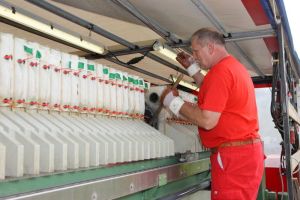Phosphorus is a vitally important element, finite, and irreplaceable. Worldwide resources that may be exploited efficiently will suffice for another 100 years. KIT scientists have developed a process for the recovery of phosphorus that is presently being applied at the sewage treatment plant of Neuburg an der Donau. In cooperation with the MSE company from Karlsbad-Ittersbach, KIT now wants to extend a mobile sludge dehydration facility with this process to recover phosphorus from the sludge concentrate.
Presently, experiments are being conducted in cooperation with MSE (Mobile Schlammentwässerungs GmbH), a subsidiary of EnBW Kraftwerke AG, to characterize the different types of wastewater separated from the solids under centrifugal force. This is “an important step prior to short- and long-term experiments that will follow,” explains Dr. Rainer Schuhmann, Head of the KIT Competence Center for Material Moisture (CMM).
By means of this new technology, “sewage treatment plants, the sludge residues of which are dehydrated on a mobile scale can also fulfill their obligations,” emphasizes the project manager of MSE, Dr. Rudolf Turek. And these requirements are getting stricter: The federation is presently discussing an obligation to recover a certain percentage of phosphorus based on a draft submitted by the Federal Ministry of the Environment in April 2011. Scientists as well as industry and sewage treatment plant operators are planned to be obliged to look for possibilities of phosphorus recovery.
Phosphorus is recovered by means of a process developed by KIT. Scientists of the Environmental Technology Division of CMM recover the phosphate dissolved in the wastewater phase by crystallization. This simple and effective principle, Rainer Schuhmann explains, “yields a high-quality fertilizer that contains phosphorus and other plant nutrients and is highly available to plants.”
In close partnership with society, KIT develops solutions for urgent challenges – from climate change, energy transition and sustainable use of natural resources to artificial intelligence, sovereignty and an aging population. As The University in the Helmholtz Association, KIT unites scientific excellence from insight to application-driven research under one roof – and is thus in a unique position to drive this transformation. As a University of Excellence, KIT offers its more than 10,000 employees and 22,800 students outstanding opportunities to shape a sustainable and resilient future. KIT – Science for Impact.

